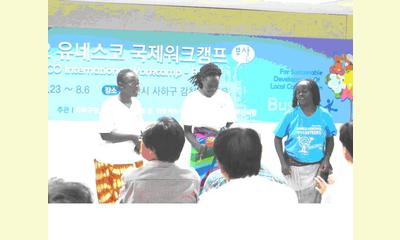|
|
World’s young volunteers promote peace, culture and sustainable development in South Korea
un article par Catherine Masunda, Synodia Chitura and Nokuthula Zinyengere (Zimbabwe)
Mutual respect, dialogue, respect for principles
of dignity, equality, peace and intercultural
tolerance can only be realized if culture (both
tangible and intangible) is respected as a firm
foundation for these aspects to be achieved. We
are three young Zimbabwean ladies who participated
in South Korean UNESCO International Workcamps
during the months of July – August 2012 at three
selected unique sites namely Jeju Island, Gyeongju
and Busan respectively running for 2 weeks each.

Zimbabwean traditional dance performance
click on photo to enlarge
The workcamps are part of UNESCO’s strategy of
action to empower young people through
participation in activities that encourage
volunteering and ensure that youth participate as
equal and valuable partners in the society. The
programme for each workcamp was designed to suit
the uniqueness of the location.
Gyeongju is a world cultural heritage site where a
traditional school called Gyeongju Hyanggyo is
found and it dates back to the 1300s. Jeju Island
is a world natural heritage site that houses the
sacred Hallasan Mountain which is 1900m above sea
level and is home of South Korean indigenous
endangered species.
15 participants attended from Austria, Czech,
Iraq, France, Kuwait, Spain , Zimbabwe, HongKong
and Taiwan. The overall theme was World Natural
Heritage Preservation and Promotion and main
activities included:
• Environment conservation –voluntary/community
work by cleaning up Jeju Island streets, weeding
and planting flowers in the flower beds
• Multicultural festival with local children and
food exchange – as a way of cultural exchange and
intolerance participants showcased culture from
their respective countries through dance, music
and preparation of food.
• World natural heritage campaign – participants
prepared a poster as a marketing tool
• Learning about South Korean culture –
participants were taught how to dye cloths using
natural dye which amazingly change color from the
original color used. They also did art work by
writing on stones and decorated the art by
covering with candle wax.
Busan is a Cultural heritage site which houses
Gamcheon-dong cultural village which was
established as a refugee camp for indigenous
religious group of Taegeukdo believers who lived
there since Korean-Japanese war of the 1950s. In
Busan, 19 young volunteers from Spain, Russia,
Taiwan, Turkey, Japan, Iraq, Hong-Kong and
Zimbabwe worked under the guidance of South Korean
leaders under the theme Sustainable Development.
Activities included:
• Preservation of tangible and intangible culture
by carrying interviews of local residents which
were recorded and produced a video as a way of
archiving the local history and marketing
purposes. Visited the Korean rice wine “makgeolli”
making factory. Work-campers produced a
documentary of a lip-dub movie entitled “One
Tribe” as a way of appreciating cultural
diversity and promoting peace and harmony among
races as one people
• Promotion of cultural diversity for dialogue and
peace – all delegates participated in the
multicultural lectures at a primary school as a
way of creating peace by marketing their
countries, linguistic diversity - which is
globalization of culture. Food exhibition and
dances
• Volunteering - through community work by
delivering pots and planting flowers
• Peace through sports (as a way of promoting
diversity of cultural expressions, linguistic
diversity) – attended a baseball match of Busan
professional baseball team called Lotte Giants
• Sustainable tourism – visited Busan Tower, Busan
Musuem, Bameosa Buddha Temple, Haundae beach, UN
memorial park, Nankodong sanctuaries.
Understanding other people’s culture brings peace in
the world.
|








|
DISCUSSION
Question(s) liée(s) à cet article:
International youth exchange programs, Do they promote a culture of peace?
* * * * *
Commentaire le plus récent:
More and more, CPNN is receiving articles about how international youth exchange programs are promoting a culture of peace in the new generation. These articles include: World’s young volunteers promote peace, culture and sustainable development in South Korea
Medical Students in the spirit of culture of peace
One World Youth Project
The 3rd UN Alliance of Civilizations Summer School
Euro-med youth exchanges: Culture of Olive Trees, Culture of Peace

|
|









